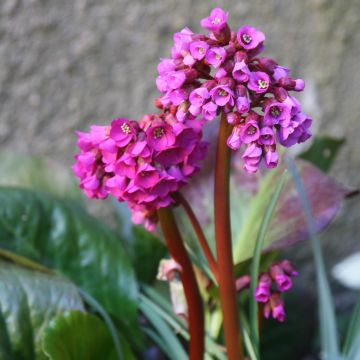

Cyrtomium fortunei var. clivicola
Cyrtomium fortunei var. clivicola
Cyrtomium fortunei var. clivicola
Fortune's holly fern, Japanese holly
This item cannot be shipped to the selected country
Delivery charge from €5.90
Delivery charge from €5.90
More information
Schedule delivery date,
and select date in basket
This plant carries a 12 months recovery warranty
More information
We guarantee the quality of our plants for a full growing cycle, and will replace at our expense any plant that fails to recover under normal climatic and planting conditions.
From €5.90 for pickup delivery and €6.90 for home delivery
Express home delivery from €8.90.
From €5.90 for pickup delivery and €6.90 for home delivery
Express home delivery from €8.90.
Does this plant fit my garden?
Set up your Plantfit profile →
Description
Cyrtomium fortunei var. clivicola, also known as Fortune's holly fern or False Fortune's shield fern, is a very attractive terrestrial and evergreen fern in a not too cold climate, slightly hardier than the type, which deserves to be better known and more widely used in our gardens, as it beautifully brightens up shady and cool areas. Its somewhat exotic appearance is due to its tough, pinnate fronds with toothed tips, a lovely light and matte green, gathered in generous clusters. Fairly tolerant of acidic or low lime soil conditions, it is slightly hardier than the species. Its stump will benefit from winter protection in very cold areas.
Cyrtomium fortunei var. clivicola, sometimes called Cyrtomium caryotydeum 'Clivicola', Polystichum falcatum 'Clivicola' or Phanerophlebia fortunei 'Clivicola', is a perennial plant in the Dryopteridaceae family. It is native to Southeast Asia (Indochina, China, Japan, Korea) and is sometimes found in the wild, having escaped from gardens.
The plant grows from short upright rhizomes covered with scales and forms a compact clump of uncut fronds, tall and wide from 40 to 60cm (16 to 24in). Each frond is divided into leaflets about ten centimetres long and 3 to 4cm (1 to 2in) wide, with undulating, toothed edges towards the top. They are tough, arranged alternately along the petiole and resemble those of Japanese Mahonia or holly. In spring, small brown dots regularly arranged can be observed on the underside of the leaves; these are the sori, small clusters of reproductive cells that will be dispersed by the wind.
The holly fern is a fairly hardy and relatively easy plant to grow, which will thrive in a sheltered spot away from the wind and afternoon sun. It will be happy in a rockery or in a damp woodland, in the company of primroses, Solomon's seals, Corydalis flexuosa, and Epimediums. It can also be paired with perennials with metallic reflections such as Heuchera 'Prince of Silver', Lamium 'Pink Pewter' or Ajuga reptans 'Atropurpurea'.
Report an error about the product description
Cyrtomium fortunei var. clivicola in pictures


Foliage
Plant habit
Botanical data
Cyrtomium
fortunei var. clivicola
Dryopteridaceae
Fortune's holly fern, Japanese holly
Southeast Asia
Other Cyrtomium
Planting and care
Cyrtomium fortunei is an easy-to-grow plant, and hardy to at least -15°C (5°F). Its foliage is theoretically evergreen, but it can be burned by severe cold or by the alternation of intense sunlight during the day and cold nights. In regions with harsh winters, it is advisable to protect the stump with a thick mulch in winter. Plant this fern in a fresh but well-drained, humus-bearing and slightly acidic soil in a sheltered spot away from strong winds and scorching rays of the sun.
Planting period
Intended location
Care
-
, onOrder confirmed
Reply from on Promesse de fleurs
Shade-loving perennials
Haven't found what you were looking for?
Hardiness is the lowest winter temperature a plant can endure without suffering serious damage or even dying. However, hardiness is affected by location (a sheltered area, such as a patio), protection (winter cover) and soil type (hardiness is improved by well-drained soil).

Photo Sharing Terms & Conditions
In order to encourage gardeners to interact and share their experiences, Promesse de fleurs offers various media enabling content to be uploaded onto its Site - in particular via the ‘Photo sharing’ module.
The User agrees to refrain from:
- Posting any content that is illegal, prejudicial, insulting, racist, inciteful to hatred, revisionist, contrary to public decency, that infringes on privacy or on the privacy rights of third parties, in particular the publicity rights of persons and goods, intellectual property rights, or the right to privacy.
- Submitting content on behalf of a third party;
- Impersonate the identity of a third party and/or publish any personal information about a third party;
In general, the User undertakes to refrain from any unethical behaviour.
All Content (in particular text, comments, files, images, photos, videos, creative works, etc.), which may be subject to property or intellectual property rights, image or other private rights, shall remain the property of the User, subject to the limited rights granted by the terms of the licence granted by Promesse de fleurs as stated below. Users are at liberty to publish or not to publish such Content on the Site, notably via the ‘Photo Sharing’ facility, and accept that this Content shall be made public and freely accessible, notably on the Internet.
Users further acknowledge, undertake to have ,and guarantee that they hold all necessary rights and permissions to publish such material on the Site, in particular with regard to the legislation in force pertaining to any privacy, property, intellectual property, image, or contractual rights, or rights of any other nature. By publishing such Content on the Site, Users acknowledge accepting full liability as publishers of the Content within the meaning of the law, and grant Promesse de fleurs, free of charge, an inclusive, worldwide licence for the said Content for the entire duration of its publication, including all reproduction, representation, up/downloading, displaying, performing, transmission, and storage rights.
Users also grant permission for their name to be linked to the Content and accept that this link may not always be made available.
By engaging in posting material, Users consent to their Content becoming automatically accessible on the Internet, in particular on other sites and/or blogs and/or web pages of the Promesse de fleurs site, including in particular social pages and the Promesse de fleurs catalogue.
Users may secure the removal of entrusted content free of charge by issuing a simple request via our contact form.
The flowering period indicated on our website applies to countries and regions located in USDA zone 8 (France, the United Kingdom, Ireland, the Netherlands, etc.)
It will vary according to where you live:
- In zones 9 to 10 (Italy, Spain, Greece, etc.), flowering will occur about 2 to 4 weeks earlier.
- In zones 6 to 7 (Germany, Poland, Slovenia, and lower mountainous regions), flowering will be delayed by 2 to 3 weeks.
- In zone 5 (Central Europe, Scandinavia), blooming will be delayed by 3 to 5 weeks.
In temperate climates, pruning of spring-flowering shrubs (forsythia, spireas, etc.) should be done just after flowering.
Pruning of summer-flowering shrubs (Indian Lilac, Perovskia, etc.) can be done in winter or spring.
In cold regions as well as with frost-sensitive plants, avoid pruning too early when severe frosts may still occur.
The planting period indicated on our website applies to countries and regions located in USDA zone 8 (France, United Kingdom, Ireland, Netherlands).
It will vary according to where you live:
- In Mediterranean zones (Marseille, Madrid, Milan, etc.), autumn and winter are the best planting periods.
- In continental zones (Strasbourg, Munich, Vienna, etc.), delay planting by 2 to 3 weeks in spring and bring it forward by 2 to 4 weeks in autumn.
- In mountainous regions (the Alps, Pyrenees, Carpathians, etc.), it is best to plant in late spring (May-June) or late summer (August-September).
The harvesting period indicated on our website applies to countries and regions in USDA zone 8 (France, England, Ireland, the Netherlands).
In colder areas (Scandinavia, Poland, Austria...) fruit and vegetable harvests are likely to be delayed by 3-4 weeks.
In warmer areas (Italy, Spain, Greece, etc.), harvesting will probably take place earlier, depending on weather conditions.
The sowing periods indicated on our website apply to countries and regions within USDA Zone 8 (France, UK, Ireland, Netherlands).
In colder areas (Scandinavia, Poland, Austria...), delay any outdoor sowing by 3-4 weeks, or sow under glass.
In warmer climes (Italy, Spain, Greece, etc.), bring outdoor sowing forward by a few weeks.

















































